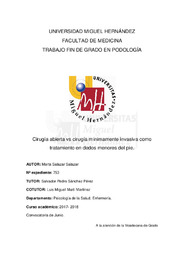Por favor, use este identificador para citar o enlazar este ítem:
https://hdl.handle.net/11000/25950Registro completo de metadatos
| Campo DC | Valor | Lengua/Idioma |
|---|---|---|
| dc.contributor.advisor | Sánchez Pérez, Salvador Pedro | - |
| dc.contributor.advisor | Martí Martínez, Luis Miguel | - |
| dc.contributor.author | Salazar Salazar, Marta | - |
| dc.contributor.other | Departamentos de la UMH::Psicología de la Salud | es_ES |
| dc.date.accessioned | 2022-02-23T09:47:19Z | - |
| dc.date.available | 2022-02-23T09:47:19Z | - |
| dc.date.created | 2018-06-21 | - |
| dc.identifier.uri | http://hdl.handle.net/11000/25950 | - |
| dc.description.abstract | Las deformidades de los dedos menores se pueden abordar mediante cirugía abierta o cirugía mínimamente invasiva. El objetivo de este trabajo es comparar la cirugía abierta con material de osteosíntesis y la cirugía MIS con osteotomías digitales para valorar si son igual de eficaces para la resolución de la deformidad. Lo realizaremos mediante varios parámetros como son la satisfacción del paciente, el dolor postquirúgico, alineación, movilidad funcional, y complicaciones. Material y métodos: Se ha realizado una revisión bibliográfica de las diferentes técnicas quirúrgicas de dedo en martillo en la plataforma Pubmed, Scopus, Web of Science y Google Scholar. Resultados y discusión: Las diferentes técnicas quirúrgicas no tienen diferencia significativa en cuanto a la satisfacción del paciente, dolor, alineación y complicaciones. Sin embargo si hay diferencia en cuanto a la movilidad ya que en la técnica abierta con osteosíntesis hay una artrodesis de la articulación. Conclusiones: Encontramos mejor movilidad con las técnicas MIS. No hay diferencia significativa en la satisfacción del paciente, el dolor, alineación y complicaciones entre MIS y artrodesis. La media de edad en los pacientes de la cirugía MIS es menor al de la cirugía abierta | es_ES |
| dc.description.abstract | The deformities of the lesser toes can fix by open surgery or minimally invasive. The objective of this work is to compare open surgery with osteosynthesis material and minimally invasive surgery with digital osteotomies to assess if they are equally effective for the resolution of the deformity. We will do it through various parameters such as patient satisfaction, post-surgical pain, alignment, functional mobility, and complications. Material and methods: A literature review of the different hammer toe surgical techniques was retrieved on the Pubmed, Scopus, Web of Science and Google Scholar platforms. Results and discussion: The two surgical techniques have no significant difference in terms of patient satisfaction, pain, alignment and complications. However, there is a difference in terms of mobility since in the open technique with osteosynthesis the joint remains immobile. Conclusions: We found better mobility with the MIS techniques. There is no significant difference in patient satisfaction, pain, alignment and complications between MIS and arthrodesis. The average age of patients with MIS surgery is less than of open surgery | es_ES |
| dc.format | application/pdf | es_ES |
| dc.format.extent | 37 | es_ES |
| dc.language.iso | spa | es_ES |
| dc.publisher | Universidad Miguel Hernández | es_ES |
| dc.rights | info:eu-repo/semantics/openAccess | es_ES |
| dc.rights | Attribution-NonCommercial-NoDerivatives 4.0 Internacional | * |
| dc.rights.uri | http://creativecommons.org/licenses/by-nc-nd/4.0/ | * |
| dc.subject | dedo de martillo | es_ES |
| dc.subject | cirugía mínimamente invasiva | es_ES |
| dc.subject | osteotomía | es_ES |
| dc.subject | dedos menores del pie | es_ES |
| dc.subject | artrodesis | es_ES |
| dc.subject.other | CDU::6 - Ciencias aplicadas | es_ES |
| dc.title | Cirugía abierta vs cirugía mínimamente invasiva como tratamiento en dedos menores del pie. | es_ES |
| dc.type | info:eu-repo/semantics/bachelorThesis | es_ES |

Ver/Abrir:
753_SALAZAR_SALAZAR_MARTA.pdf
752,51 kB
Adobe PDF
Compartir:
 La licencia se describe como: Atribución-NonComercial-NoDerivada 4.0 Internacional.
La licencia se describe como: Atribución-NonComercial-NoDerivada 4.0 Internacional.
.png)